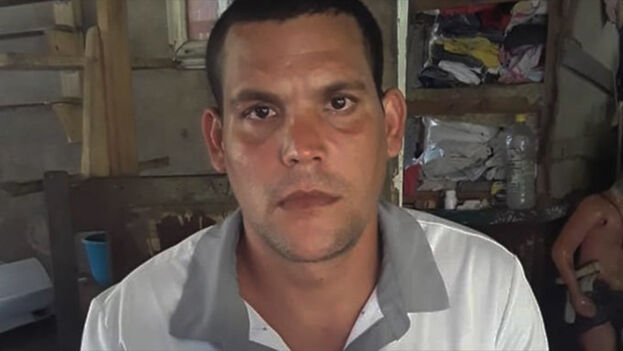
![]() 14ymedio, Havana, 12 December 2022 — Adonis Alexander Remon León is the last of the Cuban demonstrators arrested on July 11, 2021 (11J), who managed to reach the United States. According to what his mother, Elizabeth León, told Radio and Televisión Martí, the young man, 28, “is under investigation” on an American Coast Guard ship to “see if credible fear is true.” For demonstrating peacefully, the regime accused him of public disorder, attack, incitement to commit crime and damage, according to the report of detainees prepared by the Justice 11J platform.
14ymedio, Havana, 12 December 2022 — Adonis Alexander Remon León is the last of the Cuban demonstrators arrested on July 11, 2021 (11J), who managed to reach the United States. According to what his mother, Elizabeth León, told Radio and Televisión Martí, the young man, 28, “is under investigation” on an American Coast Guard ship to “see if credible fear is true.” For demonstrating peacefully, the regime accused him of public disorder, attack, incitement to commit crime and damage, according to the report of detainees prepared by the Justice 11J platform.
Remon León was placed in “home detention” awaiting trial, after spending a few months incarcerated in the Combinado del Este, the largest prison in Cuba, where he was even in the hospital in critical condition, according to the Justice 11J report. In September 2021, the measure was changed to house arrest and, released, he received threats not to take to the streets on November 15, the date that Archipelago chose for the frustrated Civic March for Change.
On December 6, he left the Island in the company of 29 other people from La Güinera, but on the journey they were intercepted by the Coast Guard. “They left looking for freedom,” said his mother, who added that they repatriated everyone from the group except Adonis, who asked for political asylum.
“He emphasized that if he returned, they would put him back in prison,” Elizabeth León stressed. Adonis had also been denied work. “They told him not to go anywhere else, that they won’t give him work here in Cuba.”
In the group of balseros [rafters] there was another 11J protester, whose name was not revealed and who was not allowed to stay on the ship. After being deported, he was arrested by State Security.
Remon León was arrested for his participation in peaceful demonstrations last year and detained for 59 days in the detention centre of the Technical Investigation Department of the Ministry of the Interior, at 100 and Aldabó. Subsequently, he was placed in pretrial detention in the Jóvenes del Cotorro prison in Havana and, finally, in the Combinado del Este, from where the precautionary measure was changed to house arrest.
Activist Salomé García Bacallao revealed through her Twitter account that the demonstrators of July 11, Yunier Soto Sanabria and Deoban Rodríguez Morales, had also fled the Island. “Everyone has the right to request political asylum, and there are enough arguments to demonstrate their credible fear.”
García Bacallao recalled that “the protests in the capital neighbourhood of La Güinera lasted until July 12, when a protester, Diubis Laurencio Tejeda, was killed by the police and others were injured, including a minor.” The regime brutalized this neighbourhood.
Last Saturday, the Coast Guard repatriated 152 balseros to Cuba on the ships Ray Evans and Charles David. According to official figures, since the first of October, 2,982 rafters have seen their attempts to reach Florida frustrated. “Every day our teams work together to protect our borders and serve the United States,” said Air Operations and Marines of Customs and Border Patrol, Gerald Burgess.
Despite the surveillance by sea and air, this Sunday the Border Patrol reported the landing of 79 rafters in Florida. The chief officer of the Miami sector, Walter Slosar, shared images of the rafts. The Cubans who arrived on them were placed in custody. Slosar mentioned that from October to date, 131 people have been arrested for “maritime smuggling.”
The balseros were also in the news in Mexico. On Friday, 10 Cubans, two women and eight men, landed on the island of the La Pasión, a protected natural area of Cozumel surrounded by mangroves. The group applied for asylum, but the immigration authorities have not yet defined their situation.
Last September, fisherman Javier Robles told 14ymedio that the escape route for Cubans through Cancún, in the Mexican state of Quintana Roo, had been reactivated. “There are people who fish at night, needless to say. Suddenly fishermen’s boats from Cancún appear in Cuba, and no one knows anything.”
The coyotes, as a Cuban revealed to this newspaper this same month, organize trips to Pinar del Río and charge Cubans $7,000. The departures, he said, respond to the despair, and “at this point many people will start leaving.”
Translated by Regina Anavy
____________
COLLABORATE WITH OUR WORK: The 14ymedio team is committed to practicing serious journalism that reflects Cuba’s reality in all its depth. Thank you for joining us on this long journey. We invite you to continue supporting us by becoming a member of 14ymedio now. Together we can continue transforming journalism in Cuba.
